How the Soviet Union's end sparked a grand rewilding
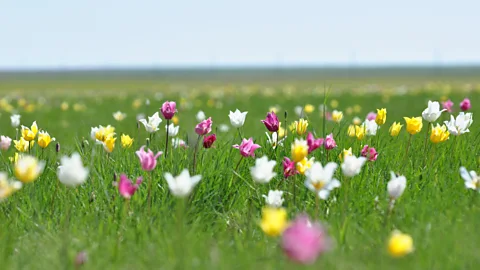 Alyona Koshkina
Alyona Koshkina
After thousands of people left the steppes of Kazakhstan, nature began to reclaim it on a huge scale.
When Alyona Koshkina walks through the wild grasses of Kazakhstan’s vast plains in spring, she is overwhelmed by the life blooming around her. Migratory birds zip overhead through a sprawling sky, greenery shimmers, ocean-like in the breeze, and flowers dot the landscape with specks of purple, yellow, white and red.
“You have always this sound of wind in your ears,” she says. “It’s very open.” Koshkina, a researcher at the Association for the Conservation of Biodiversity of Kazakhstan (ACBK), knows this treeless habitat – called steppe – intimately.
“You can see somebody approaching you from a very long distance, an animal or people or a car… and you feel very safe and relaxed,” she adds.
The sheer size of the Kazakh steppe is difficult to comprehend. The wide, relatively flat plains stretch across an area roughly as big as Germany, Poland, the Czech Republic and Austria combined. Kazakhstan is, after all, the eighth-largest country in the world.
But these seemingly boundless wildlife havens were not always devoid of human activity. Since the Soviet Union collapsed in 1991, hundreds of thousands of people have vacated the grasslands. Unprofitable farms once relied on money from the Soviet regime to survive. When the funds dried up, many people were forced to look elsewhere for work.
You may also like:
The Kazakh steppe is not an untouched wilderness but, rather, an abandoned one – a place that is halfway to being “rewilded”. And by land area, it's possibly one of the largest spaces on Earth returned to nature in recent years.
The extent to which the Kazakh steppe has changed in the 30 years since the end of the Soviet Union is difficult to understand because so few people have studied it. Its scale also makes research difficult. But in recent years, Koshkina and others have turned to photos taken by satellites to try and grasp how these majestic grasslands – and the wildlife they hold – have transformed. The picture that has emerged is one of a unique landscape, rich with nature, sporadically scarred by fire, and only occasionally interrupted by a few abandoned settlements.
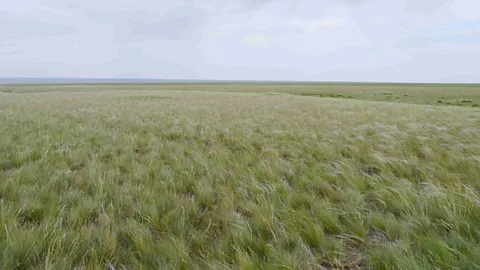 Martin Freitag
Martin Freitag
The Kazakh Soviet Socialist Republic, as it was then known, had been a member of the Soviet Union since 1936. One major change of that era was that collectivised farms overtook nomadic shepherding in the steppes – but they were not as successful as the Soviets had hoped.
Over time, as in many Soviet states, dissatisfaction with authorities grew, reaching a peak during the 1980s, with political turmoil and rioting. In the end, Kazakhstan became the last republic to secede from the Soviet Union, on 16 December 1991. It was soon recognised as an independent state. The removal of Soviet economic infrastructure had a huge impact. By 1995, GDP in Kazakhstan had fallen by 36%. Unemployment rose and the proportion of people living below the poverty line grew from 25% in 1992 to 43.4% in 1999.
Koshkina remembers the 1990s as a difficult time, with electricity shortages and some families left struggling for food and other basic supplies. Her own partner grew up in a village on the steppe, near to a nature reserve, but moved elsewhere like so many others, for economic reasons.
“Still he feels very much attached to this area,” says Koshkina. “We go there almost every weekend and he feels sad for leaving the village.”
Since then, many farms have morphed back into grassy patches, dozens of ruined buildings lie crumbling, and equipment such as water pumps – formerly used by farmers to source water for their livestock – stand unused.
Until recently, it was difficult for researchers to see the full extent of this change, and its effect on nature. Johannes Kamp, a conservation scientist at the University of Göttingen, has been studying the wildlife of Kazakhstan for 15 years – but he remembers when he started in the early 2000s having to piece together his understanding from fieldwork.
That changed with access to satellite imagery – via programmes such as Landsat and public websites including Google Earth and Bing, which allowed Kamp and other ecologists to see how the region evolved across a much larger scale over time. As he clicked through image after image of the landscape, the reality of life on the Kazakh steppe began to emerge.
 Johannes Kamp/Google Maps
Johannes Kamp/Google Maps
Images of the steppe snapped from orbit revealed that thousands of human settlements had collapsed into disrepair. Kamp and his team have scoured pictures of more than 2,000 villages or towns and 1,300 livestock stations, the vast majority of which have were fully or partly abandoned after 1991.
As for nature, some things remain unchanged. Across the steppe, Koshkina, Kamp and colleagues used Google Earth and Bing satellite images to map the locations of more than 7,000 Bobak marmot burrows. The marmots are a type of ground squirrel, not unlike groundhogs. The imagery revealed that the area inhabited by the creatures – all six million of them – has remained the same since the 1950s.
For other species, it's a different story. “Some animals got rarer, some got more abundant, some disappeared completely,” says Kamp. “I was witnessing, over these 15 years, how these land use changes affected the whole species community.”
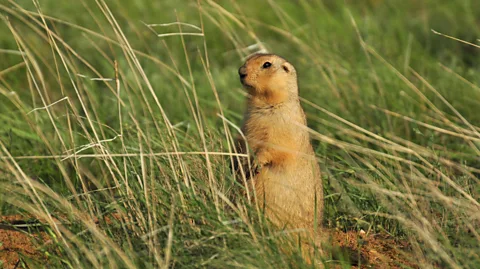 Alyona Koshkina
Alyona Koshkina
In another study that Kamp worked on with Martin Freitag at the University of Munster and colleagues, satellites revealed that much larger swathes of Kazakhstan are succumbing to wildfires than they were previously. In one area, roughly the size of Germany, the team found many more pockets of severely burned habitat in images from 2015 than were visible in pictures from 1990.
“Kazakhstan is now a global fire hotspot,” says Kamp. “We see at least a tenfold increase in the area of grassland that is burning now.”
Why has this happened? Since the fall of the Soviet Union, fewer and fewer farmers have been bringing their livestock out onto the wilderness of the steppe to graze. Livestock in the region has plummeted, say the researchers. Data from the United Nations’ Food and Agriculture Organization reveals that the number of sheep on the Kazakh steppe fell from 33 million in 1992 to 8.7 million in 1999. Cattle numbers dropped from 9.5 million to 4 million.
Long grasses that grow unimpeded thrive in the spring but turn dry thanks to the Sun and brisk wind of the steppe in summer, which makes it easier for fire to spread.
Freitag explains that, in order for the steppe ecosystem to remain in balance, it requires a significant amount of grazing so that fires do not take over every year. To get a closer look at how wildlife in these grasslands was faring, the team used the satellite images to help them decide where to carry out research in the field – and that, they say, is where the true magic of the steppe becomes apparent.
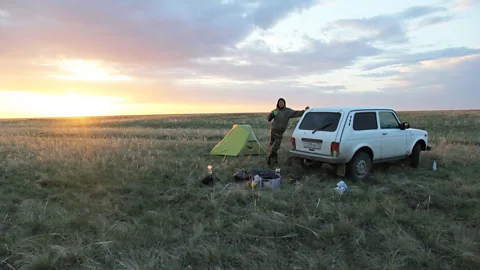 Johannes Kamp
Johannes Kamp
On those expeditions, Freitag recalls how a symphony of skylarks would wake him up at 04:00 or so every morning. The thin material of his tent did little, if anything, to dampen the birds’ joyous calls. In 2016, he and his colleagues were in the field in the middle of the Kazakh steppe, travelling off-road while conducting biological surveys and collecting soil samples. Day after day, they would stalk the grasslands, noticing a stunning variety of plant and animal life.
Koshkina mentions how her mother, also from Kazakhstan, complains that the steppe seems barren – she expects forests and mountains. When you drive through the steppe, it appears to be nothing but monotonous expanses of endless grass. But that grass is full of surprises. Freitag mentions the wild tulips, for instance.
“When the snow has melted and it becomes a bit warmer at the end of April, the massive flowering of tulips is really most colourful,” he says.
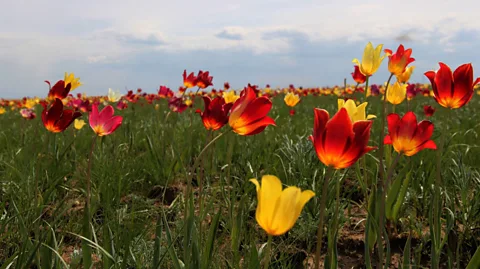 Johannes Kamp
Johannes Kamp
And there are many birds, besides the skylarks, such as sociable lapwings, a critically endangered species that breeds almost exclusively in Kazakhstan, and pallid harriers – majestic birds of prey that migrate elsewhere for the winter. They’ve even been known to travel as far as Great Britain.
Then there are the wild grazers. One of the most iconic animals of the Eurasian steppe is the saiga antelope, a small antelope with a characteristically long nose. Its flappy, broad nostrils hang down at the front of its face. The saiga almost looks like a creature from another world.
In the post-Soviet era, poaching led to a huge decline in saiga numbers in Kazakhstan – in fact they neared extinction. And in 2015, a BBC camera crew observed hundreds of thousands of saiga die on the steppe after a bacterial infection spread through their population.
But EJ Milner-Gulland, who has studied these antelope for years, says there has been better news of late. Saiga numbers more than doubled in the two years to 2019 and now total more than 330,000 (though there hasn’t been a population count in 2020 due to Covid-19).
“It’s a major success story,” says Milner-Gulland. The saiga population could grow yet further, which would increase grazing on the steppe and balance the ecosystem in other ways, too. More dung means more food for insects, and when the antelope die their carcasses are scavenged by birds and other animals.
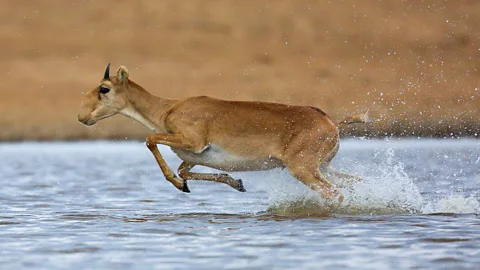 Dmitry Rogulin/Getty Images
Dmitry Rogulin/Getty Images
Milner-Gulland would love to see a million saiga in Kazakhstan once again – the sort of number that roamed the steppe pre-1991. But she would settle for half that.
Protecting the saiga from poaching and ensuring that their routes are not blocked by fencing or infrastructure, could increase their numbers. There are also projects to reintroduce other wild grazers such as the kulan, a type of wild ass.
But a rewilded steppe is not necessarily one without any human influence. In some places farmers are returning, swallowing up wild grasslands as they do.
Centuries ago, the grasslands were home to nomadic farmers, who moved their livestock from place to place for grazing. They shared the steppe with saiga, kulan and wild horses. But most farmers in the region now keep their livestock in one place, says Koshkina.
“It’s not moving any more from one place to another, it’s just grazing around the villages or a farm in very short distances,” she explains. “That is not what is needed for these steppes.”
Ironically, the abandonment of the steppe has exposed the fact that specific forms of human activity could benefit wildlife. But whether Kazakhstan will bolster populations of grazing animals, facilitate the return of nomadic shepherds, and establish more protected areas remains to be seen.
The country’s population, having declined by nearly 1.5 million post-1991, is now growing again. So too is its economic output. Kazakhstan is poised to experience huge changes in the years to come and some of those may threaten the fragile wilderness of the steppe. Exploitation of large oil reserves in the grasslands, for example, could lead to increasing industrialisation. And Koshkina worries about how much land will eventually be converted once more into farms – “dead fields”, she says, laced with pesticide.
“There is a window of opportunity to restore this ecosystem that has been left by people,” she adds. “As I see it, this window is closing soon.”
--
If you liked this story, sign up for the weekly bbc.com features newsletter, called "The Essential List". A handpicked selection of stories from BBC Future, Culture, Worklife, and Travel, delivered to your inbox every Friday.
